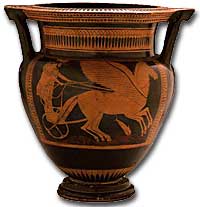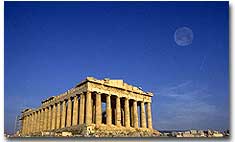5e. Art and Architecture

One popular form of Greek art was pottery. Vases, vessels, and kraters served both practical and aesthetic purposes. This krater depicts Helios, the sun god, and dates from the 5th century B.C.E.
The arts reflect the society that creates them. Nowhere is this truer than in the case of the ancient Greeks. Through their temples, sculpture, and pottery, the Greeks incorporated a fundamental principle of their culture: arete. To the Greeks, arete meant excellence and reaching one's full potential.
Ancient Greek art emphasized the importance and accomplishments of human beings. Even though much of Greek art was meant to honor the gods, those very gods were created in the image of humans.
Much artwork was government sponsored and intended for public display. Therefore, art and architecture were a tremendous source of pride for citizens and could be found in various parts of the city. Typically, a city-state set aside a high-altitude portion of land for an acropolis, an important part of the city-state that was reserved for temples or palaces. The Greeks held religious ceremonies and festivals as well as significant political meetings on the acropolis.

Greek Excellence: The Acropolis
In ancient Athens, Pericles ordered the construction of several major temples on the acropolis. Among these was a temple, the Parthenon, which many consider the finest example of Greek architecture.
Built as a tribute to Athena, the goddess of wisdom for whom the city-state Athens was named, the Parthenon is a marvel of design, featuring massive columns contrasting with subtle details.

Three different types of columns can be found in ancient Greek architecture. Whether the Doric, Ionic, or Corinthian style was used depended on the region and the purpose of the structure being built.
Many barely noticeable enhancements to the design of the Parthenon contribute to its overall beauty and balance. For example, each column is slightly wider in the middle than at its base and top. The columns are also spaced closer together near the corners of the temple and farther apart toward the middle. In addition, the temple's steps curve somewhat — lower on the sides and highest in the middle of each step.
Sadly, time has not treated the Parthenon well. In the 17th century, the Turks, who had conquered the Greeks, used the Parthenon to store ammunition. An accidental explosion left the Parthenon with no roof and in near ruin. In later years, tourists hauled away pieces of the Parthenon as vacation souvenirs.
Beauty in the Human Form
Ancient Greek sculptures were typically made of either stone or wood and very few of them survive to this day. Most Greek sculpture was of the freestanding, human form (even if the statue was of a god) and many sculptures were nudes. The Greeks saw beauty in the naked human body.
Early Greek statues called kouros were rigid and stood up straight. Over time, Greek statuary adopted a more natural, relaxed pose with hips thrust to one side, knees and arms slightly bent, and the head turned to one side.
Other sculptures depicted human action, especially athletics. A good example is Myron's Discus Thrower Another famous example is a sculpture of Artemis the huntress.The piece, called "Diana of Versailles," depicts the goddess of the hunt reaching for an arrow while a stag leaps next to her.
Among the most famous Greek statues is the Venus de Milo, which was created in the second century B.C.E. The sculptor is unknown, though many art historians believe Praxiteles to have created the piece. This sculpture embodies the Greek ideal of beauty.
The ancient Greeks also painted, but very little of their work remains. The most enduring paintings were those found decorating ceramic pottery. Two major styles include red figure (against a black background) and black figure (against a red background) pottery. The pictures on the pottery often depicted heroic and tragic stories of gods and humans.






